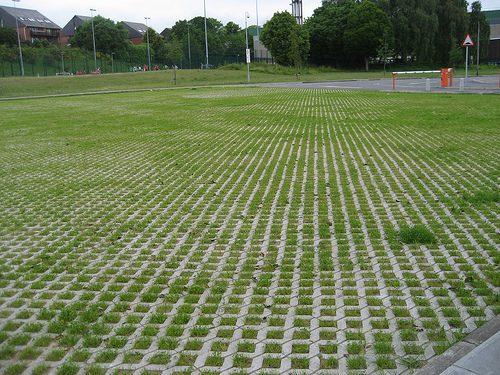Grasscrete is a cast-on-site cellular reinforced concrete paving surface that has a defined pattern of voids. It is placed by pouring concrete over a void former, a type of mold. Grasscrete is cast on-site by pouring concrete over these formers, which creates voids in the concrete. Once formed these voids can be filled with a variety of porous materials such as grassed soil or stone allowing water to percolate through the concrete. It is installed over a sub-base of gravel, native soils and over a deep bed of crushed stone, stormwater chambers etc.
Advantages of Grasscrete
Grasscrete is lightweight and can withstand high traffic loads. It is used as a structural paving surface for parking areas, spillways, storm/drainage channels etc. It can be also used as stabilization of soil in areas that experience seasonal runoff, that require maximum water capacity to handle that such as of an adjacent hard surface. It can be customized to suit a wide variety of applications where the elimination of retention ponds, swales, or other stormwater management is required. Grasscrete self-drains and can help to prevent flooding issues downstream.
Advantages;
- Structural Cast In Place System
- Eliminate Costly Infrastructure
- Low Maintenance Costs
- Environmental Benefits
- Stormwater Infiltration
- Increase Green Space /Reduce Heat Island Effect
- Differential Settlement Resistant and Self-Draining
- High Load Bearing Capacity
- Edge Details not Required
- Resists Differential Settlement
- WithstandFreeze-Thaw & Protects Slope
- Lower Sub-base Depth Needed
- Flood prevention

Different types of Grasscrete
There are three types of Grasscrete systems Concealed, Partially concealed and Stone filled.
Partially Concealed Grasscrete
In partially concealed grasscrete, the concrete and grass are placed parallel. Thick concrete is provided along with root protection alongside the vegetation.
Concealed Grasscrete:
In concealed grasscrete concrete is placed in between two layers of soil, the upper soil being thinner than the soil beneath the concrete which is fully concealed. It is ideal for low-traffic areas, where traffic volume is minimum.
Stone-Filled Grasscrete:
In stone-filled grasscrete, concrete is placed with crushed stone. This type of grasscrete is suitable for draining.
Grasscrete Installation method
Grasscrete is supplied in units arranged “upside-down egg box style. The units are laid on the prepared surface to create a continuous mold and steel reinforcement mesh is then laid on top with formers. Concrete is then poured over the formers. Once the concrete has reached sufficient strength the surface is torched to burn out the formers. This opens up the voids inside the mold and it only remains to spread topsoil over the paving and seed it.

The application process;
Surface preparation
- Prepare the surface with an edge framework and a consolidated sub-base.
- The sub-base should be rolled in place
Erection of formwork
Before laying the formers edge formwork should be erected
Lay Formers
- Place formers edge to edge
- The formers of Grasscrete are laid alongside each other leaving the space at the edge
Mesh Reinforcements
Place the mesh reinforcements on formers on the up-spacers located between the main up-stand of the former.
Pouring Concrete
- Concrete is poured into the former
- Make sure that the concrete is placed around the former and mesh, and leveled to the top of the formers.
- Squeegees are used to level off the concrete to the top of the former
- The solid margins are toweled and concrete is allowed for 48 hours to harden
Melt Former Tops with Flame Guns
The top of the plastic formers is burnt out with the help of an LPG flame gun.
Top Soil and Seed
- Fine soil fills the pocket in the Grasscrete which is then watered to allow settlement.
- After the initial settlement, the planting must be watered daily over a few weeks to establish grass cover.
- After that, watering is required until the grass grows completely.
Applications of Grasscrete;
- Vehicle parking
- Access roads
- Fire and emergency access
- Laybys/pull-ins
- Highway verges
- Abnormal load diversions
- SUDS (sustainable urban drainage system)
- Slope protection
- Drainage channels
- Spillways
Conclusion
Grasscrete combines the environmental appeal of natural grass with reinforced concrete and is used for a variety of applications. Grasscrete also not only maintains the natural equilibrium of the groundwater recharge, but it significantly reduces runoff. In an upcoming article, we will analyze grasscretes’ detailed applications.

